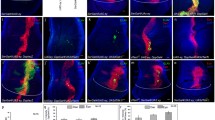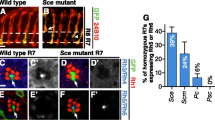Abstract
The sevenless (sev) cascade plays an inductive role in formation of the R7 photoreceptor, whilst the pokkuri (pok) and tramtrack (ttk) gene products are known to repress R7 induction in developing ommatidia of Drosophila melanogaster. To elucidate how these positive and negative signalling mechanisms co-operate in the normal fate determination of R7, genetic interactions of mutations in the pok locus with ttk and downstream elements of sev including Gap1, raf1, rolled (r1) and seven in absentia (sina) were examined. The eye phenotype of a weak hypomorph, pok 15, was enhanced dominantly by Gap1-mip, a recessive mutation in a gene encoding a down-regulator of Ras1, producing multiple R7 in ommatidia. Ras1 has been reported to activate r1-encoded mitrogen-activated protein (MAP) kinase via Raf1 that is associated physically with Rasl. Ommatidia of raf1 c110 and rl 2/rlEMS64 typically lacked R7 and a few outer photoreceptors. The pok 1 mutation suppressed dominantly the rafl c110 rl2/rlEMS64 eye phenotypes, allowing single R7 cells to develop in ommatidia. The rafl c110 mutation improved adult viability of pok 1 homozygotes. An in vitro experiment demonstrated that MAP kinase phosphorylates Pok protein. Ttk is a transcriptional repressor which binds to the regulatory sequence upstream of the fushi-tarazu (ftz), even skipped (eve) and engrailed (en) coding region. A reduced activity in ttk resulted in enhancement of the pok phenotype. ttk mutations produced extra R7 cells even in sina homozygotes whilst the pok mutation did not. This result indicates that Ttk represses R7 induction downstream of the sites where Pok and Sina function.
Similar content being viewed by others
References
Banerjee U, Renfranz PJ, Hinton DR, Rabin BA, Benzer S (1987) The sevenless + protein is expressed apically in cell membranes of developing Drosophila retina; it is not restricted to cell R7. Cell 51:151–158
Basler K, Hafen E (1991) Specification of cell fate in the developing eye of Drosophila. BioEssays 13:621–631
Biggs WH, Zipursky SL (1992) Primary structure, expression, and signal-dependent tyrosine phosphrylation of a Drosophila homolog of extracellular signal-regulated kinase. Proc Natl Acad Sci USA 89:6295–6299
Biggs WH, Zavitz KH, Dickson B, Straten A van der, Brunner D, Hafen E, Zipursky SL (1994) The Drosophila rolled locus encodes a MAP kinase required in the Sevenless signal transduction pathway. EMBO J 13:1628–1635
Bohmann D, Ellis MC, Staszewski LM, Mlodzik M (1994) Drosophila jun mediates ras-dependent photoreceptor determination. Cell 78:973–986
Bonfini I, Karlovich CA, Dasgupta C, Benerjee U (1992) The son of sevenless gene product: a putative activator of ras. Science 255:603–606
Brown JL, Wu C (1993) Repression of Drosophila pair-rule segmentation genes by ectopic expression of tramtrack. Development 117:45–58
Brown JL, Sonoda S, Ueda H, Scott MP, Wu C (1991) Repression of the Drosophila fushi tarazu (ftz) segmentation gene. EMBO J 10:665–674
Brunner D, Oellers N, Szabad J, Biggs WH, Zipursky SL, Hafen E (1994a) A gain-of-function mutation in Drosophila MAP kinase activitates multiple receptor tyrosine kinase signaling pathways. Cell 76:875–888
Brunner D, Dücker K, Oellers N, Hafen E, Scholz H, Klämbt C (1994b) The ETS domain protein Pointed-P2 is a target of MAP kinase in the Sevenless signal transduction pathway. Nature 370:386–389
Buckles GR, Smith ZDJ, Katz FN (1992) mip causes hyperinnervation of a retinotopic map in Drosophila by excessive recruitment of R7 photoreceptor cells. Neuron 8:1015–1029
Campos-Ortega JA, Jurgens G, Hofbauer A (1979) Cell clones and pattern formation: Studies on sevenless, a mutant of Drosophila melanogaster. Wilhelm Roux's Arch Dev Biol 186:27–50
Carthew RW, Rubin GM (1990) Seven in absentia, a gene required for specification of R7 cell fate in the Drosophila eye. Cell 63:561–577
Carthew RW, Neufeld TP, Rubin GM (1994) Identification of genes that interact with the sina gene in Drosophila eye development. Proc Natl Acad Sci USA 91:11689–11693
Chang HC, Solomon NM, Wassarman DA, Karim FD, Therrien M, Rubin GM, Wolff T (1995) phyllopod functions in the fate determination of a subset of photoreceptors in Drosophila. Cell 80:463–472
Chen RH, Abate C, Blenis J (1993) Phosphorylation of the c-Fos transrepression domain by mitogen-activated protein kinase and 90-kDa ribosomal S6 kinase. Proc Natl Acad Sci USA 90:10952–10956
Dickson B (1995) Nuclear factors in sevenless signalling. Trends Genet 11:106–111
Dickson B, Sprenger F, Morrison D, Hafen E (1992a) Raf functions downstream of Ras 1 in the Sevenless signal transduction pathway. Nature 360:600–603
Dickson B, Sprenger F, Hafen E (1992b) Prepattern in the developing Drosophila eye revealed by an activated torso-sevenless chimeric receptor. Genes Dev 6:2327–2339
Dickson BJ, Domínguez M, Straten A van der, Hafen E (1995) Control of Drosophila photoreceptor cell fates by Phyllopod, a novel nuclear protein acting downstream of the Raf kinase. Cell 80:453–462
Eberl DF, Durf BJ, Hilliker AJ (1993) The role of heterochromatin in the expression of a heterochromatic gene, the rolled locus of Drosophila melanogaster. Genetics 134:277–292
Fortini ME, Simon MA, Rubin GM (1992) Signaling by the sevenless protein tyrosine kinase is mimicked by ras 1 activation. Nature 355:559–561
Gaul U, Mardon G, Rubin GM (1992) A putative ras GTPase activating protein acts as a negative regulator of signaling by the sevenless receptor tyrosine kinase. Cell 68:1007–1019
Guo M, Bier E, Jan LY, Jan YN (1995) tramtrack acts downstream of numb to specify distinct daughter cell fates during asymmetric cell divisions in the Drosophila PNS. Neuron 14:913–925
Harrison SD, Travers AA (1990) The tramtrack gene encodes a Drosophila finger protein that interacts with the ftz transcriptional regulatory region and shows a novel embryonic expression pattern. EMBO J 9:207–216
Hart AC, Krämer H, Zipursky SL (1993) Extracellular domain of the boss transmembrane ligand acts as an antagonist of the Sev receptor. Nature 361:732–736
Jan YN, Jan LY (1994) Genetic control of cell fate specification in Drosophila peripheral nervous system. Annu Rev Genet 28:373–393
Klämbt C (1993) The Drosophila gene pointed encodes two ETS-like proteins which are involved in the development of the midline glial cells. Development 117:163–176
Laemmli UK (1970) Cleavage of structural proteins during the assembly of the head of bacteriophage T4. Nature 227:680–685
Lai Z-C, Rubin GM (1992) Negative control of photoreceptor development in Drosophila by the product of the van gene, an ETS domain protein. Cell 70:609–620
Lindsley DL, Zimm GG (1992) The genome of Drosophila melanogaster. Academic Press, San Diego, p 1123
Miyamoto H, Nihonmatsu I, Kondo S, Ueda R, Togashi S, Hirata K, Ikegami Y, Yamamoto D (1995) canoe encodes a novel protein containing a “GLGF/DHR motif” and functions with Notch and scabrous in common developmental pathways in Drosophila. Genes Dev 9:612–625
Moses K, Ellis MC, Rubin GM (1989) The glass gene encodes a zinc-finger protein required by Drosophila photoreceptor cells. Nature 340:531–536
Nakajima T, Kinoshita S, Sasagawa T, Sasaki K, Naruto M, Kishimoto T, Akira S (1993) Phosphorylation at threonine-235 by a ras-dependent mitogen-activated protein kinase cascade is essential for transcription factor NF-IL6. Proc Natl Acad Sci USA 90:2207–2211
Nakamura M, Okano H, Blendy JA, Montell C (1994) Musashi, a neural RNA binding protein required for Drosophila adult external sensory organ development. Neuron 13:67–81
Neufeld TP, Rubin GM (1994) The Drosophila peanut gene is required for cytokinesis and encodes a protein similar to yeast putative bud neck filament proteins. Cell 77:371–379
Nishida Y, Hata M, Ayaki T, Ryo H, Yamagata M, Shimizu K, Nishizuka Y (1988) Proliferation of both somatic and germ cells is affected in the Drosophila mutants of raf proto-oncogene. EMBO J 7:775–781
Olivier JP, Raabe T, Henkemeyer M, Dickson B, Mbamalu G, Margolis B, Schlessinger J, Hafen E, Pawson T (1993) A Drosophila SH2-SH3 adaptor protein implicated in coupling the sevenless tyrosine kinase to an activator of Ras guanine nucleotide exchange, Sos. Cell 73:179–191
O'Neill EM, Rebay I, Tjian R, Rubin GM (1994) The activities of two Ets-related transcription factors required for Drosophila eye development are modulated by the Ras/MAPK pathway. Cell 78:137–147
Remaekers G, Usui K, Usui-Ishihara A, Ramaekers A, Ghysen A, Dambly-Chaudière C (1995) Lineage and fate in Drosophila: role of the gene tramtrack in sense organ development. EMBO J, in press
Read D, Manley JL (1992) Alternatively spliced transcripts of the Drosophila tramtrack gene encode zinc finger proteins with distinct DNA binding specificities. EMBO J 11:1035–1044
Read D, Levine M, Manley JL (1992) Ectopic expression of the Drosophila tramtrack gene results in multiple embryonic defects, including repression of even-skipped and fushi tarazu. Mech Dev 38:183–196
Ready DF (1989) A multifaceted appraoch to neural development. Trends Neurosci 12:102–110
Rebay I, Rubin GM (1995) Yan functions as a general inhibitor of differentiation and is negatively regulated by activation of the Ras1/MAPK pathway. Cell 81:857–866
Reinke R, Zipursky SL (1988) Cell-cell interaction in the Drosophila retina: The bride of sevenless gene is required in cell R8 for R7 cell development. Cell 55:321–330
Rogge RD, Karlovich CA, Banerjee U (1991) Genetic dissection of a neurodevelopmental pathway: Son of sevenless functions downstream of the sevenless and EGF receptor tyrosine kinases. Cell 64:39–48
Rogge R, Cagan R, Majumdar A, Dulaney T, Banerjee U (1992) Neuronal development in the Drosophila retina: The sextra gene defines an inhibitory component in the developmental pathway. Proc Natl Acad Sci USA 89:5271–5271
Robertson HM, Preston CR, Phillis RW Johnson-Schlitz DM, Denz WK, Engels WR (1988) A stable source of P-element transposase in Drosophila melanogaster. Genetics 118:461–470
Rubin GM (1988) Drosophila melanogaster as an experimental organism. Science 240:1453–1459
Rubin GM (1989) Development of the Drosophila retina: inductive events studied at single cell resolution. Cell 57:519–520
Salzberg A, D'Evelyn D, Schulze KL, Lee J-K, Strumpf D, Tsai L, Bellen HJ (1994) Mutations affecting the pattern of the PNS in Drosophila reveal novel aspects of neuronal development. Neuron 13:269–287
Simon MA, Bowtell DDL, Dodson GS, Laverty TR, Rubin GM (1991) Ras1 and a putative guanine nucleotide exchange factor perform crucial steps in signaling by the sevenless protein tyrosine kinase. Cell 67:701–716
Simon MA, Dodson GS, Rubin GM (1993) An SH3-SH2-SH3 protein is required for p21Ras1 activation and binds to Sevenless and Sos protein in vitro. Cell 73:169–177
Smith DB, Johnson KS (1988) Single step purification of polypeptides expressed in Escherichia coli as fusions with glutathione s-transferase. Gene 67:31–40
Tei H, Nihonmatsu I, Yokokura T, Ueda R, Sano Y, Okuda T, Sato K, Hirata K, Fujita SC, Yamamoto D (1992) pokkuri, a Drosophila gene encoding an E-26-specific(Ets)-domain protein, prevents overproduction of the R7 photoreceptor. Proc Natl Acad Sci USA 89:6856–6860
Tomlinson A (1988) Cellular interactions in the developing Drosophila eye. Development 104:183–193
Tomlinson A, Ready DF (1987a) Neuronal differentiation in the Drosophila ommatidium. Dev Biol 120:366–376
Tomlinson A, Ready DF (1987b) Cell fate in the Drosophila ommatidium. Dev Biol 123:264–275
Tsuda L, Inoue YH, Yoo M-A, Mizuno M, Hata M, Lim Y-M, Adachi-Yamada T, Ryo H, Masamune Y, Nishida Y (1993) A protein kinase similar to MAP kinase activator acts downstream of the Raf kinase in Drosophila. Cell 72:407–414
Usui K, Ghysen A, Kimura K (1994) Spacing pattern of the microchaetes on the notum of Drosophila. Abstracts of the 5th European Symposium on Drosophila neurobiology, La Grande Motte, p 37
Van Vactor DL, Capan RL, Krämer H, Zipursky SL (1991) Induction in the developing compound eye of Drosophila: Multiple mechanisms restrict R7 induction to a single retinal precursor cell. Cell 67:1145–1155
Xiong W-C, Montell C (1993) tramtrack is a transcriptional repressor required for cell fate determination in the Drosophila eye. Genes Dev 7:1085–1096
Yamamoto D (1993) Positive and negative signaling mechanisms in the regulation of photoreceptor induction in the developing Drosophila retina. Genetica 88:153–164
Yamamoto D (1994) Signaling mechanisms in induction of the R7 photoreceptor in the developing Drosophila retina. BioEssays 16:237–244
Ziprusky SL (1989) Molecular and genetic analysis of Drosophila eye development: sevenless, bride of sevenless and rough. Trends Neurosci 12:183–189
Author information
Authors and Affiliations
Rights and permissions
About this article
Cite this article
Yamamoto, D., Nihonmatsu, I., Matsuo, T. et al. Genetic interactions of pokkuri with seven in absentia, tramtrack and downstream components of the sevenless pathway in R7 photoreceptor induction in Drosophila melanogaster . Roux's Arch Dev Biol 205, 215–224 (1996). https://doi.org/10.1007/BF00365799
Received:
Accepted:
Issue Date:
DOI: https://doi.org/10.1007/BF00365799




